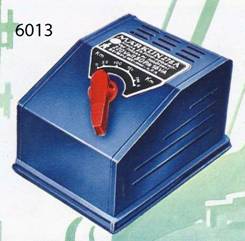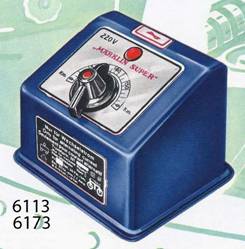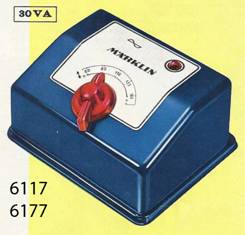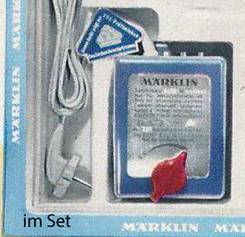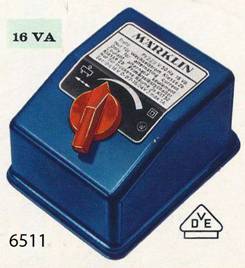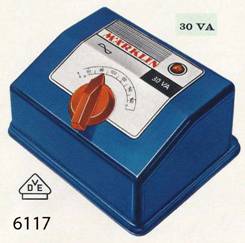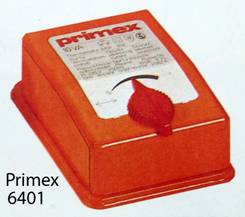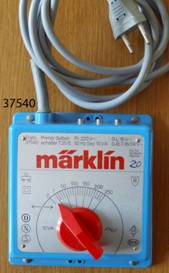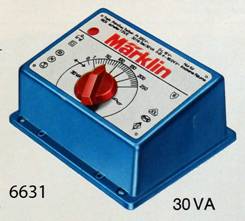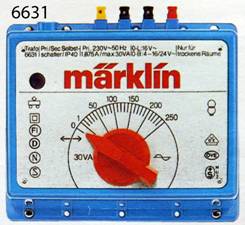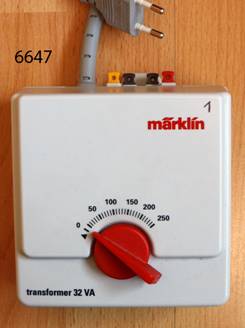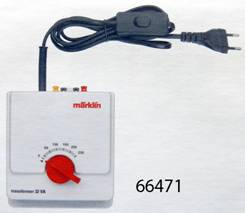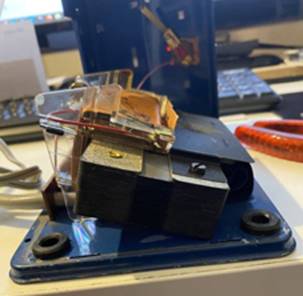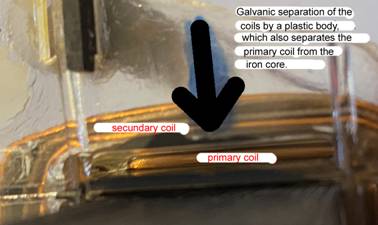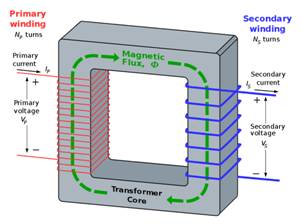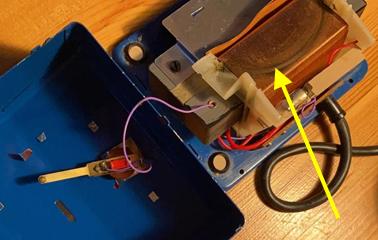|
|
|
|||||||||||||
|
The Prototype Märklin-H0-Knowledge Layout-Building Modelstock |
|
|||||||||||||
|
A: The very first
basic knowlege about conventionally controlled Märklin H0 model railways A4: White – blue – orange – |
|
|||||||||||||
|
ATTENTION: Safety-relevant topic!!! The topic of the old Märklin
transformers is a recurring one.
The
white Märklin transformers no. 6647, 66470, 66471 are recommended in the area
of power supply with 230V. But other mothers have beautyful
daughters too… First, let’s take a look at the
Märklin transformers since 1949. Only transformers for 220V or 230V
and for the German market are listed. A click on a transformer image shows
the catalog sheet of the respective year. |
|
|||||||||||||
|
|
10VA |
16VA |
30VA |
|||||||||||
|
blue sheet metal housing |
||||||||||||||
|
1949 |
|
|||||||||||||
|
At that time, the round plug, as
shown in the pictures, was the „normal appliance plug“. |
||||||||||||||
|
1952 |
|
(15VA) |
||||||||||||
|
1953 |
|
|||||||||||||
|
From 1957 onwards, all Märklin
products were given new numbers with unchanged design. In the 1950s, the SCHUKO system gradually
replaced the previous normal round plugs and flat sockets in |
||||||||||||||
|
1957 |
|
|||||||||||||
|
1960 |
||||||||||||||
|
From 1960 the contour plug with the
shape of a SCHUKO plug became standard in Märklin assured in the catalog:
“This transformer complies with the lastest official
regulations.” or “…latest regulations of the VDE”, from 1961 on: “The
transformer … has been tested and approved by the VDE.” |
||||||||||||||
|
1962 |
|
|||||||||||||
|
1965 |
||||||||||||||
|
1968 |
||||||||||||||
|
From 1968 onwards, the mains cables
were fitted with the “unified plug”, toda called the EURO plug. The two Primex transformers also date
from this time. |
||||||||||||||
|
|
identical
in construction 6413 |
|
identical
in construction6117 |
|||||||||||
|
blue plastic housing, EURO plug |
||||||||||||||
|
1973 |
still sheet metal housing |
|||||||||||||
|
1975 |
In 1975, the sheet metal
transformer 6511 was still listed in the German catalog without picture. |
|||||||||||||
|
From 1992 onwards, the plastic
transformers were fitted with safety terminals instead of sockets at the
output. |
||||||||||||||
|
1992 |
|
|||||||||||||
|
|
white plastic housing 32VA |
|||||||||||||
|
1994 |
Only with the Alpha
programm |
|
||||||||||||
|
1996 |
|
|
||||||||||||
|
Numbers
become 5 digits. |
||||||||||||||
|
2011 |
|
|
||||||||||||
|
A power switch is added. |
||||||||||||||
|
2016 |
|
|
||||||||||||
|
Now we examine why oder transformers
should be used with caution or better not. The problems with the older
transformers are: 1st: the current electrical regulations 2nd: the ageing of the insulating
materials in the transformer and the connection cable 3rd: the increase of the mains voltage
from 220V ±22V to 230V ±23V since 1987/2009 (see Wikipedia) To 1st: The applicable electrical regulations Some applicable regulations
contradict the operation of the old sheet metal transformers. Unacceptable
insulating materials, even if they were new, construction features of the
components. The transformers up to 1959 in the
table lack protective insulation. Please do not use them any more! I disposed
of mine. The protective insulation can be
recognised by the symbol on the type plate: a square within a square. The
transformers from 1960 onwards therefore have protective insulation. All transformers with a double
square in the type plate should be safe, but you can only be completely sure
if you have the transformer checked by a recognised specialist company,
especially for the condition of the protective insulation. Make sure that the supply cable is
intact and free of cracks or brittle changes. The transformers are not suitable or
approved for damp rooms. This means that some basements are
unsuitable for operation. For further, more in-depth
explanation, I bring here the report of a member of my Facebook group, the
master electrician Dieter Hammerl: The
tale of the blue metal transformer with the red rotary knob, which is
dangerous. To put an end to this discussion, I took the liberty of scrapping one
of my transformers today. Since it is now open, it has lost its operating licence. I am a master electrician and could close this transformer again so
that it could be used, but I won't do it; who knows what else it is good for.
The first picture shows which kind of transformer it is. |
|
|||||||||||||
|
The second picture shows the connection side with the symbols. |
|
|||||||||||||
|
On the third and fourth picture you can see the transformer assembly. |
|
|||||||||||||
|
|
|
|||||||||||||
|
|
|
|||||||||||||
|
The sixth picture shows the protective insulation that prevents an
active conductor (wire) from touching the housing. |
|
|||||||||||||
|
In the case of the transformer shown, mechanical precautions have been
taken to ensure that no conductive connection can occur between an active
conductor (230V) and the housing. However, this also presupposes that the
transformer is still in the original condition in which it was delivered from
the factory. As soon as the transformer shows deformations or changes in
colour or massive rusting or the connection cable is porous and the
insulation is possibly already crumbling or partially missing, the transformer
has lost its operating licence and must be disposed of. The transformer
should also be disposed of if the connection cable has been replaced and
there is no new safety certificate on the transformer issued by a specialist
electrical company. The statements only refer to the electrical operational safety. I cannot rule out the possibility that this transformer will fry
decoders or send electronic components to nirvana heaven with its switching
voltage, as I only drive conventionally.
The last picture also shows a blue transformer, but with a plastic
housing. I advise against using even older transformers, as they have reached
their end of life. In general, if you don't have a good feeling about using the transformer
described or another transformer with a metal housing because you don't know
whether it has been operated in accordance with the regulations, dispose of
the transformer. End of quote To 2nd: The ageing
of the insulating materials in the transformer and the connecting cable. Many a person has had an old cable
crumble in their hands. Replacing the supply cable requires opening the
riveted housing, which can lead to uncontrollable new damage inside. The
effort and the new risk are not worth it. The old blue Märklin transformers
with sheet metal housings are many decades old and meanwhile "End of
Life", are no longer considered safe to operate. And another quote from Dieter
Hammerl: For all
those who think that transformers with a blue housing and a red regulator
could lead to a fatal electric shock. As I have written in other posts, these transformers are
"protective insulated" and produce a "protective extra-low
voltage" suitable for toys. "Protective insulated" means that no active wire or active
component (230 V) can touch the metal housing. "Protective extra-low voltage" means that the windings
(coils) are galvanically separated and also cannot touch the transformer
core. It also means that no "autotransformer" may be used. By BillC - Own work, CC BY-SA 3.0,
https://commons.wikimedia.org/w/index.php?curid=524847 What is
an "autotransformer"? (see Wikipedia) (Graphic
by BillC - Own work, CC BY-SA 3.0)
Autotransformers must not be used for toys! But if you want to do something extra for your safety, you can have the
circuit to which the transformers are connected by means of a Europlug (the
flat plug without a protective contact) equipped with its own
residual-current device (RCD). This is a change to the sub-distribution and
must be carried out by a recognised electrical specialist, i.e. your favourite
electrical installation company. What
does this residual-current device (RCD) do? If, contrary to expectations, the connection between an active
component and the housing, which is often invoked, should occur, you will receive
an electric shock from the transformer when touching the housing. However,
this is not dangerous because the residual current circuit breaker ensures
that a maximum voltage of less than 50 V can build up across the resistor,
i.e. the connection between you and the transformer housing and your contact
with the ground. And 50 V is not dangerous for you. If it is not possible for you to have an additional residual-current
device (RCD) installed in the distribution board, ask your trusted electrical
installation company to build you a small distribution board from an
insulated housing. He will provide the supply line with a protective contact
plug, which you can then plug into your socket and at the other end he will
build a socket strip with 10 or more sockets. Please do not plug any other multiple sockets into the sockets here,
otherwise you will lose your insurance cover. According to the recognised
rules of technology and the rules of property insurers, it is not permitted
to plug other multiple sockets into a multiple socket. |
|
|||||||||||||
|
So: Not like that... (Photo: Herbert Otto,
Father's workroom) And in all confidence, which modeltrain specialist has not plugged at least
one multiple socket into a multiple socket? I would be much more concerned
about this than about whether an ACTIVE COMPONENT can touch the housing of a
device with protective insulation. The basis of this consideration is always the fact that the Märklin
transformers used are still in their original condition and the cable or
housing does not yet have any damage. Damages are among others:
etc. End of quote To 3rd: The
increase of the mains voltage from 220V ±22V to 230V ±23V since 1987/2009 (see Wikipedia) I would like to add some basic
knowledge to Dieter's comments: What is "the mains voltage": 230 volts AC with 50 hertz
frequency. Where does this apply? |
|
|||||||||||||
|
|
||||||||||||||
|
This was not always the case: Before 1987, when transformers were
manufactured for 220 volts, the mains voltage was allowed to be between 198 and
242 volts (220±22V) and that is what the transformers were built for. In a transitional period between
1987 and 2009, the mains voltage was allowed to be between 207 and 243.8
volts. However, the manufacturers knew which rule would come after that and built
their devices for the voltage range 207 to 253 volts (230±23V), which still
applies today. The actual mains voltage varies
regionally and also depends on the large consumers in the area. Where I live
in the northern outskirts of Physical principles
of the transformer 1st fact: A current-carrying
conductor causes a magnetic field in its surroundings (discovery by Hans
Christian Ørsted in 1820). (Wikipedia) If you take several insulated wires
in parallel and send current through them in the same direction, you get a
stronger magnetic field, the individual magnetic fields add up. If you wrap the insulated wire
around an iron core, you build an electromagnet. (This only works with iron
materials, with a few exceptions. Problem: iron can rust...) An electromagnet works with both
direct current and alternating current. With direct current, the iron core tends
to become permanently magnetic itself. This does not happen with alternating
current. 2nd Fact: When you move a
wire through a magnetic field, the magnetic field in the wire creates an
electric voltage. (Demonstrated: induction on the conductor
swing). Mind you, there has to be movement: If you feed an electromagnet with
alternating current, the magnetic field constantly builds up and degrades.
It's like moving the wire. So the wire may be stationary and yet a voltage is
generated in it.
You expose a second coil to the
magnetic field of an electromagnet fed with alternating current, preferably
by winding both coils on a common iron core. Image by BillC at the
English-language Wikipedia, CC BY-SA 3.0,
https://commons.wikimedia.org/w/index.php?curid=27407689 The number of turns of the two coils
determines how the electrical voltage is transmitted: For example, if the number of turns
of the two coils is in a ratio of In the Märklin transformer there are
such two coils on a common iron core, optimised for the purpose of model
railway supply. The wires are insulated with only
very thin varnish. The number of windings is chosen in
such a way that 230V at the input results in 4V (in the case of the Märklin
transformer 6647, 66470, 66471) at the output. Why only 4V? As mentioned, the insulating lacquer
around the wires is only very thin. It is removed at certain points so that
the pick-up finger of the controller knob can touch the bare wires.
For the 25V switching voltage, there
are more turns, but they are not reached by the pick-up finger, but are
tapped directly and are available to the left of the 0-point. Once this is understood, it is clear
that a transformer built for 220V delivers somewhat higher output voltages at
230V mains voltage. In addition, there are manufacturing tolerances that
sometimes lead to values that cannot be fully explained. If you then add the changed
permissible tolerances, some old transformers can produce unpleasantly high
voltages at the limits of the permissible mains voltage. Unpleasant above all
for electronic components... If you operate a digitalised
traction unit in conventional mode and use a transformer that generates too
high a switching voltage, the electronics can be destroyed. The critical limit
is probably a good 30V; exact details are nowhere to be found. The ratio of input voltage to output
voltage is invariably determined by the number of winding turns. A transformer that was built for
220V ±22V and brought a switching voltage of 21.6V to 26.4V can today bring
up to 27.6V. That is the theory and does not
sound particularly dangerous. A modern transformer for 230±23V has
coils adapted to the voltage difference from 220V to 230V. Therefore it
should also deliver 21.6V to 26.4V. Now I have measured my most modern
Märklin transformer no. 6647. And lo and behold, at 253V input it
delivers max. 27.9V at the output. It should have delivered 26.4V,
which is 1.5V more. So far, no traction unit has been
damaged by this transformer. Therefore, I assume that approx. 28V
is still harmless. However, I have at least one member
in the group who has had decoders break down with a white transformer. I have measured all my transformers. The following ranking list refers to
the reversing switch voltage at 230V mains. |
|
|||||||||||||
|
rank |
brand |
no |
housing |
power |
for V |
reverse voltage at 230V mains |
|
|||||||
|
1 |
Märklin |
6647
|
plastic |
32VA |
230V |
25,2V |
|
|||||||
|
2 |
Titan)* |
808M
|
sheet
metal |
60VA |
220V |
25,5V |
|
|||||||
|
3 |
Märklin |
6631 |
plastic |
30VA |
230V |
26,2V |
|
|||||||
|
4 |
Titan)* |
109M
at |
sheet
metal / plastic)* |
60VA |
220V |
26,4V |
|
|||||||
|
5 |
Märklin |
6173 |
sheet
metal |
30VA |
220V |
27,2V |
|
|||||||
|
6 |
Märklin
|
6631 |
plastic |
30VA |
220V |
27,5V |
|
|||||||
|
7 |
Märklin |
6413 |
sheet
metal |
10VA |
220V |
28,8V |
|
|||||||
|
8 |
Märklin |
6511 |
sheet
metal |
16VA |
220V |
29,0V |
|
|||||||
|
9 |
Primex |
6401 |
sheet
metal |
10VA |
220V |
29,1V |
|
|||||||
|
10 |
Märklin |
37540 |
plastic |
10VA |
220V |
30,1V |
|
|||||||
|
)* The Titan system transformers each consist of
a mother transformer and plug-in controller units. The worst is Märklin No. 37540 with
over 30V, at 253V mains up to 33V. Actually a modern transformer with
plastic housing. So the plastic housing is not a sign
I would not operate a digital
locomotive with this one, at most permanently set for a track without
switching. That's the recommendation for people
who can't throw anything away. Märklin writes about this (German): https://www.maerklin.de/fileadmin/media/service/faq/Technik-Tipp-207.pdf Light transformers |
|
|||||||||||||
|
1965 |
6210 |
|
||||||||||||
|
1968 |
6211 |
|
||||||||||||
|
1973 |
6611 |
|
||||||||||||
|
1974 |
6611 |
|
||||||||||||
|
1992 |
6002 |
|
||||||||||||
|
2005 |
60052 |
|
||||||||||||
|
I own only one 6611 in the design
from 1974. Furthermore I own a light
transformer from Piko, No. Z1 1756, giving and a light transformer from Roco,
No. 10725, giving |
|
|||||||||||||
|
The Prototype Märklin-H0-Knowledge Layout-Building Modelstock |
|
|||||||||||||
|
state: 07.01.2024 15:13 |
|
|||||||||||||
|
Contact:
Mail |
|
|||||||||||||








